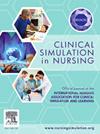Effectiveness of a virtual simulation and self-debriefing app on nursing students' pediatric pain knowledge: A randomized controlled trial
IF 2.5
3区 医学
Q1 NURSING
引用次数: 0
Abstract
Background
Knowledge retention and decision-making skills are important in clinical nursing practice. A virtual child-based simulation and self-debriefing learning application (app) was developed for pediatric pain assessment and management.
Method
Third-year nursing students received either classroom instruction on pediatric pain (control group (CG), n = 84) or instruction and a virtual simulation learning app (intervention group (IG), n = 100). Differences in pediatric pain knowledge scores between groups before instruction (T0) versus postinstruction (T1) and versus one-month postinstruction/simulation (T2) examined the effect of the intervention on knowledge retention. Three simulation tasks were used to assess the thinking and actions taken (right thinking/right action) by the IG.
Results
General estimating equations indicated that knowledge scores increased significantly from T0 to T2 for the IG compared to the CG (β = 6.826, p = .016), indicating better knowledge retention. Right thinking/right action for all simulation tasks was achieved by only 22.0% of the IG.
Conclusions
Our findings suggest that virtual scenario-based teaching should include self-briefing to ensure that the correct actions taken during simulations reflect correct thinking about the problem.
虚拟模拟和自我汇报应用程序对护生儿科疼痛知识的有效性:一项随机对照试验
知识保留和决策能力在临床护理实践中非常重要。开发了一款基于儿童的虚拟模拟和自我汇报学习应用程序(app),用于儿童疼痛评估和管理。方法三年级护生分别接受儿童疼痛课堂教学(对照组84例)和虚拟模拟学习应用(干预组100例)。教学前(T0)与教学后(T1)、教学后/模拟1个月(T2)两组儿童疼痛知识得分的差异检验了干预对知识保留的影响。通过三个模拟任务来评估IG的思维和行动(正确的思维/正确的行动)。结果一般估计方程表明,从T0到T2, IG组的知识得分明显高于CG组(β = 6.826, p = 0.016),表明IG组的知识保留更好。对所有模拟任务的正确思考/正确行动只有22.0%的IG实现。结论我们的研究结果表明,基于虚拟场景的教学应该包括自我简报,以确保在模拟过程中采取的正确行动反映了对问题的正确思考。
本文章由计算机程序翻译,如有差异,请以英文原文为准。
求助全文
约1分钟内获得全文
求助全文
来源期刊

Clinical Simulation in Nursing
NURSING-
CiteScore
5.50
自引率
15.40%
发文量
107
期刊介绍:
Clinical Simulation in Nursing is an international, peer reviewed journal published online monthly. Clinical Simulation in Nursing is the official journal of the International Nursing Association for Clinical Simulation & Learning (INACSL) and reflects its mission to advance the science of healthcare simulation.
We will review and accept articles from other health provider disciplines, if they are determined to be of interest to our readership. The journal accepts manuscripts meeting one or more of the following criteria:
Research articles and literature reviews (e.g. systematic, scoping, umbrella, integrative, etc.) about simulation
Innovative teaching/learning strategies using simulation
Articles updating guidelines, regulations, and legislative policies that impact simulation
Leadership for simulation
Simulation operations
Clinical and academic uses of simulation.
 求助内容:
求助内容: 应助结果提醒方式:
应助结果提醒方式:


